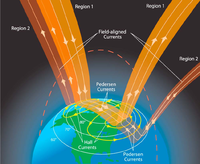
Photo from wikipedia
Many studies that have shown that the ionospheric, polar cap electric potentials (PCEP) exhibit a “saturation” behavior in response to the level of the driving by the solar wind. As… Click to show full abstract
Many studies that have shown that the ionospheric, polar cap electric potentials (PCEP) exhibit a “saturation” behavior in response to the level of the driving by the solar wind. As the magnitude of the interplanetary magnetic field (IMF) and electric field (IEF) increase, the PCEP response is linear at low driving levels, followed with a roll-over to a more constant level. While there are several different theoretical explanations for this behavior, so far no direct observational evidence has existed to confirm any particular model. In most models of this saturation, the interaction of the field-aligned currents (FAC) with the solar wind/magnetosphere/ionosphere system has a role. As the FAC are more difficult to measure, their behavior in response to the level of the IEF has not been investigated as thoroughly. In order to resolve the question of whether or not the FAC also exhibit saturation, we have processed the magnetic field measurements from the Orsted, CHAMP, and Swarm missions, spanning more than a decade. As the amount of current in each region needs to be known, a new technique is used to separate and sum the current by region, widely known as R0, R1, and R2. These totals are found separately for the dawn and dusk sides. Results indicate that the total FAC has a response to the IEF that is highly linear, continuing to increase well beyond the level at which the electric potentials saturate. The currents within each region have similar behavior.
Journal Title: Journal of Geophysical Research
Year Published: 2017
Link to full text (if available)
Share on Social Media: Sign Up to like & get
recommendations!